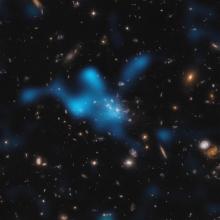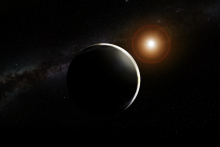Listen to today's episode of StarDate on the web the same day it airs in high-quality streaming audio without any extra ads or announcements. Choose a $8 one-month pass, or listen every day for a year for just $30.
You are here
Moon and Venus
Scientists define the length of a day as 24 hours. But a day can vary by about a thousandth of a second — a millisecond — the result of storms, earthquakes, or other big events. The shortest day ever recorded came last July — one and a half milliseconds shorter than average.
A day on the planet Venus can vary by about 20 minutes.
Venus is roughly the same size and mass as Earth. But it spins in the opposite direction. And a recent study found that the average length of its day is a skosh more than 243 Earth days.
Measuring the length of a Venus day isn’t easy. The planet’s surface is hidden by clouds. That rules out using mountains or other features to time Venus’s rotation. Instead, scientists use radio telescopes as radar guns. They shoot beams of radio waves toward the planet, then measure the “echo.” A shift in the reflected waves reveals details about the planet’s rotation.
The recent study successfully “shot” Venus with radio waves more than 20 times over 15 years. Each observation revealed a slightly different rotation speed — a different length of day.
The changes probably are caused by the motions of Venus’s atmosphere, which is much heavier than Earth’s atmosphere. As it moves across the surface, it trades momentum with the solid planet — changing the length of a day.
Venus is the blazing “evening star” right now. Tonight, it’s close to the crescent Moon as twilight fades away.
Script by Damond Benningfield





